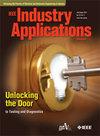Holistic Fault Detection, Classification, and Localization in ADNs With Optimally Placed D-PMUs
IF 4.2
2区 工程技术
Q2 ENGINEERING, ELECTRICAL & ELECTRONIC
引用次数: 0
Abstract
Effective fault detection allows distribution system operators (DSOs) to provide reliable power to customers in active distribution networks (ADNs). Advantages include faster maintenance, less downtime, fewer critical system events, economic benefits, and prevention of network-wide cascading faults. In this paper, a new fault detection, classification, and localization (FDCL) method is developed that uses optimally placed distribution-level phasor measurement units (D-PMUs) to track positive, negative, and zero-sequence components considering unique distribution network attributes (UDNA). A simple feed-forward neural network (FFNN) detects and classifies faults, while an ensemble bagged trees (EBT) classifier approximates line fault location at a high fault resolution. A coordinated localization strategy using nearby D-PMUs reduces fault localization error further. The proposed voltage-induced transient method also correlates fault impedance and ground resistance. The IEEE-13, IEEE-34, and IEEE-123 test feeders verify the method's fidelity, including topology changes, spontaneous renewable integration effects alongside various D-PMU placement methods. Computational optimization through cloud computing and ADN splitting workflow is also established.求助全文
约1分钟内获得全文
求助全文
来源期刊

IEEE Transactions on Industry Applications
工程技术-工程:电子与电气
CiteScore
9.90
自引率
9.10%
发文量
747
审稿时长
3.3 months
期刊介绍:
The scope of the IEEE Transactions on Industry Applications includes all scope items of the IEEE Industry Applications Society, that is, the advancement of the theory and practice of electrical and electronic engineering in the development, design, manufacture, and application of electrical systems, apparatus, devices, and controls to the processes and equipment of industry and commerce; the promotion of safe, reliable, and economic installations; industry leadership in energy conservation and environmental, health, and safety issues; the creation of voluntary engineering standards and recommended practices; and the professional development of its membership.
 求助内容:
求助内容: 应助结果提醒方式:
应助结果提醒方式:


